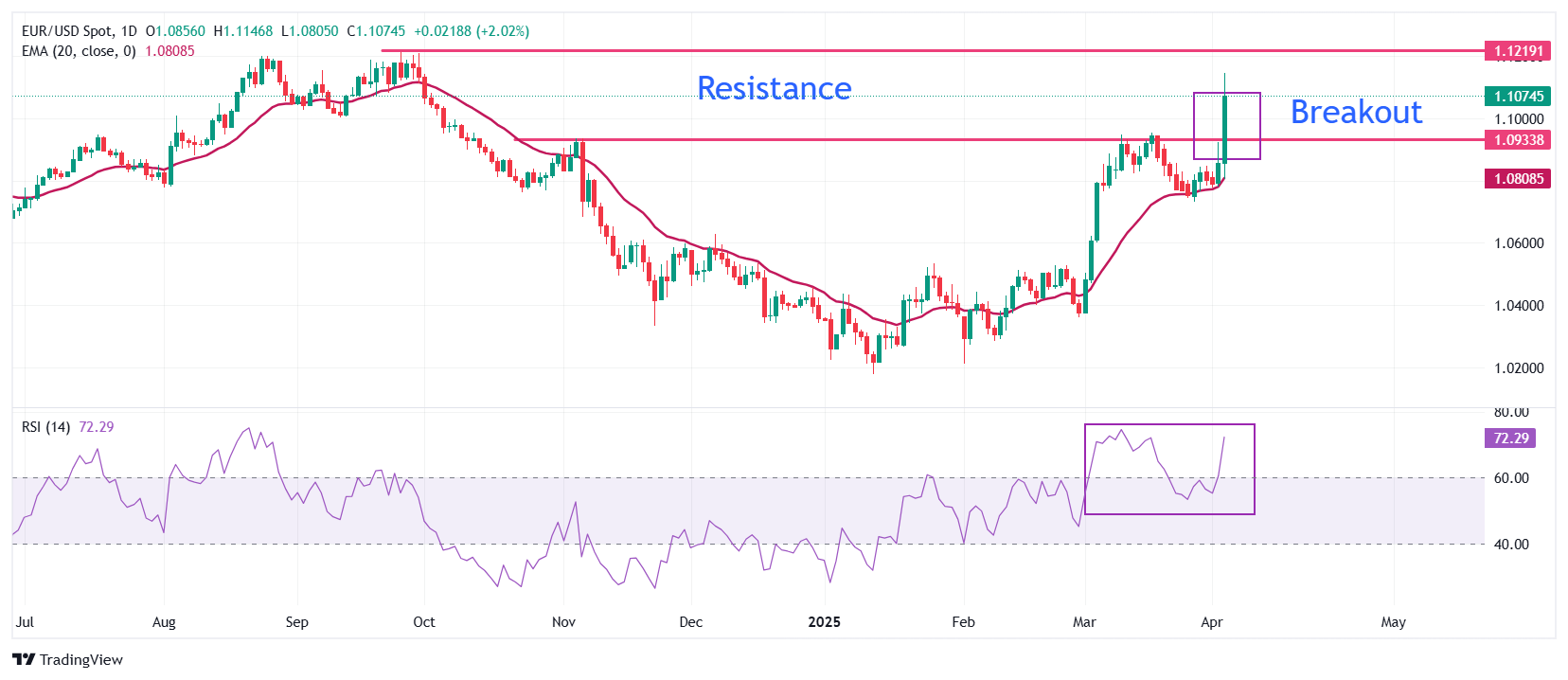- EUR/USD soars to near 1.1145 as the US Dollar has been hit hard by Trump’s reciprocal tariffs announcement.
- US President Trump has announced 20% reciprocal levies on the Eurozone.
- EC von der Leyen vows to retaliate if negotiations with Washington fail.
EUR/USD climbs to its highest level since October around 1.1145 in Thursday’s North American session and gains an almost 2.5% on the day. The major currency pair strengthens by Euro’s (EUR) outperformance even though fears of a potential trade war between the US and the Eurozone have escalated after United States (US) President Donald Trump announced 20% reciprocal tariffs on the European Union (EU).
European Commission (EC) President Ursula von der Leyen stated that the consequences will be “dire for millions of people around the globe”. She warned that the old continent is prepared to retaliate with countermeasures if negotiations with Washington end without a healthy conclusion. Von der Leyen further added that the EC is already finalising the “first package of countermeasures” in response to tariffs on steel and is now preparing for further countermeasures to protect our “businesses and interests”.
Last month, von der Leyen warned of imposing tariffs on up to 26 billion Euros worth of imports from the US as a countermeasure for Trump’s sweeping 25% levies on steel and aluminum imports, which became effective on March 12.
Meanwhile, European Central Bank (ECB) officials have ruled out expectations that tariff-driven inflation could dent hopes of more interest rate cuts. During European trading hours, ECB policymaker and Governor of Bank of Greece Yannis Stournaras said that US tariffs will not be an “obstacle to April rate cut” as the inflation path remains “unchanged”. Stournaras guided that US tariffs will “negatively impact” the Euro area Gross Domestic Product (GDP) growth rate by “0.3%-0.4%” in the first year.
Daily digest market movers: EUR/USD rallies amid weakness in US Dollar
- The major drive behind sheer strength in the EUR/USD pair is the falling US Dollar (USD), which takes the bullet for long-term transition in the US economy. The US Dollar Index (DXY), which gauges the Greenback’s value against six major currencies, nosedives to near 101.30, the lowest level seen in six months.
- On Wednesday, US Council of Economic Advisers Chair Stephen Miran agreed that tariffs announced by US President Donald Trump could lead to short-term bumps in the economy but will be favorable for long-term prospects. His comments came after Trump unveiled planned reciprocal tariffs. Trump announced a 10% baseline duty on all imports to the US and additional specific levies on most of its trading allies. Some leaders from targeted nations have threatened to retaliate with countermeasures.
- Market participants expect Trump’s tariffs will lead to a global economic slowdown, including in the US. Experts believe that new import duties are higher than expected and sufficient to send the US economy into a recession. Such a scenario paves the way for stagflation, assuming that higher levies will dampen efforts made by the Federal Reserve (Fed) to contain sticky inflationary pressures. This will complicate the Fed’s job of maintaining inflation near the 2% target with full employment.
- Going forward, investors will focus on the US Nonfarm Payrolls (NFP) data for March, which will be released on Friday. The official employment data will influence market expectations for the Fed’s monetary policy outlook. On Wednesday, the ADP Employment Change data showed that the private sector added 155K fresh workers in March, significantly higher than the expectations of 105K and the former release of 84K.
- In Thursday’s session, investors will pay close attention to the S&P Global and the ISM Services Purchasing Managers Index (PMI) data for March, which will be published during North American trading hours. The S&P Global Services PMI is estimated to align with the preliminary reading of 54.3. The ISM Services PMI is expected to come in lower at 53.0 from February’s reading of 53.5, suggesting that activities in the services sector grew moderately.
Technical Analysis: EUR/USD eyes more upside towards 1.1200

EUR/USD rallies to near 1.1150 on Thursday after a decisive breakout above the prior resistance of 1.0955, trading at levels not seen since early October. The near-term outlook of the major currency pair has turned extremely bullish as the 20-day Exponential Moving Average (EMA) resumes its upside journey, trading around 1.0800.
The 14-day Relative Strength Index (RSI) jumps around 70.00 after cooling down to near 60.00, suggesting that the bullish momentum has resumed.
Looking down, the mid-March resistance zone around 1.0955 is the first support to consider, followed by the March 31 high of 1.0850. Conversely, the September 25 high of 1.1214 will be the key barrier for the Euro bulls.
Economic Indicator
Nonfarm Payrolls
The Nonfarm Payrolls release presents the number of new jobs created in the US during the previous month in all non-agricultural businesses; it is released by the US Bureau of Labor Statistics (BLS). The monthly changes in payrolls can be extremely volatile. The number is also subject to strong reviews, which can also trigger volatility in the Forex board. Generally speaking, a high reading is seen as bullish for the US Dollar (USD), while a low reading is seen as bearish, although previous months’ reviews and the Unemployment Rate are as relevant as the headline figure. The market’s reaction, therefore, depends on how the market assesses all the data contained in the BLS report as a whole.
Read more.

























